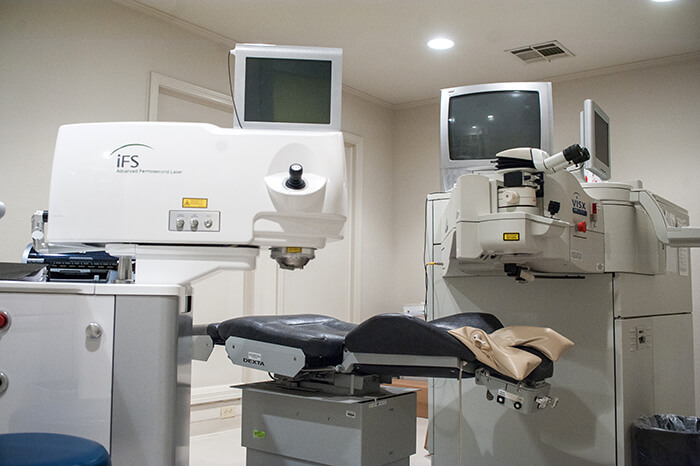Intralase/Blade Free LASIK
LASIK surgery involves two basic steps: creating a corneal flap and reshaping the cornea according to prescription. Traditionally, the corneal flap during LASIK has been created with a microkeratome blade. It is well documented that a large part of the risks and complications from LASIK arise during the creation of the flap. Surgical techniques have been modified and instruments have been refined to improve the results and decrease complications, but nothing has made as significant an impact on improving LASIK as the IntraLase femtosecond laser.
This instrument utilizes an infrared laser and I-LASIK software to create a corneal flap at a pre-programmed depth and position. As a low-pressure soft suction ring holds the eye, the laser cleaves the corneal tissue at the predetermined depth forming bubbles of water and carbon dioxide at that plane. These bubbles connect to create a smooth surface that will become the interface between the flap and the corneal bed. The laser energy neither alters corneal curvature nor affects the prescription. There is no damage or change to the surrounding tissue.
The 3-micron laser spot size gives a very smooth ablation with pinpoint accuracy. The IntraLase pattern zigzags the laser energy starting at the hinge and then continuing back and forth across the cornea. Finally, the laser cuts the edge of the flap circumferentially, leaving the hinge area untouched. The whole process takes approximately one minute per eye.

The obvious advantages of a flap created with IntraLase over a microkeratome are that there is little to no possibility of corneal abrasion, thin flap, thick flap, partial flap, incorrect diameter, or buttonhole flap. No one has ever gone blind or needed a corneal transplant with IntraLase. Furthermore, because the flap is uniform thickness from center to edge (like a manhole cover), there is less chance of flap slippage or wrinkling if accidentally rubbed or bumped during healing after surgery. Also, because the resulting flap is uniform thickness across the diameter, the I-LASIK is ideal for far-sightedness, high amounts of nearsightedness, large pupils, moderate to high astigmatism, and small corneal diameters where producing a large enough flap for treatment far into the periphery is critical. Yet another advantage is the ability to create a very thin flap so as to maintain optimal corneal thickness when treating higher prescriptions or thinner corneas.

Because IntraLase programs the laser to produce flaps with vertical edges (again, like a manhole cover), it is more difficult for the outer layer of cells to migrate down under the flap into the interface since the length of the route for those cells is increased.
The I-LASIK approach has brought LASIK surgery to a whole new level of safety and precision for our patients. Because we feel this is very compelling technology that significantly raises the standard for safety in vision correction surgery, we are recommending the I-LASIK approach for ALL our patients.


